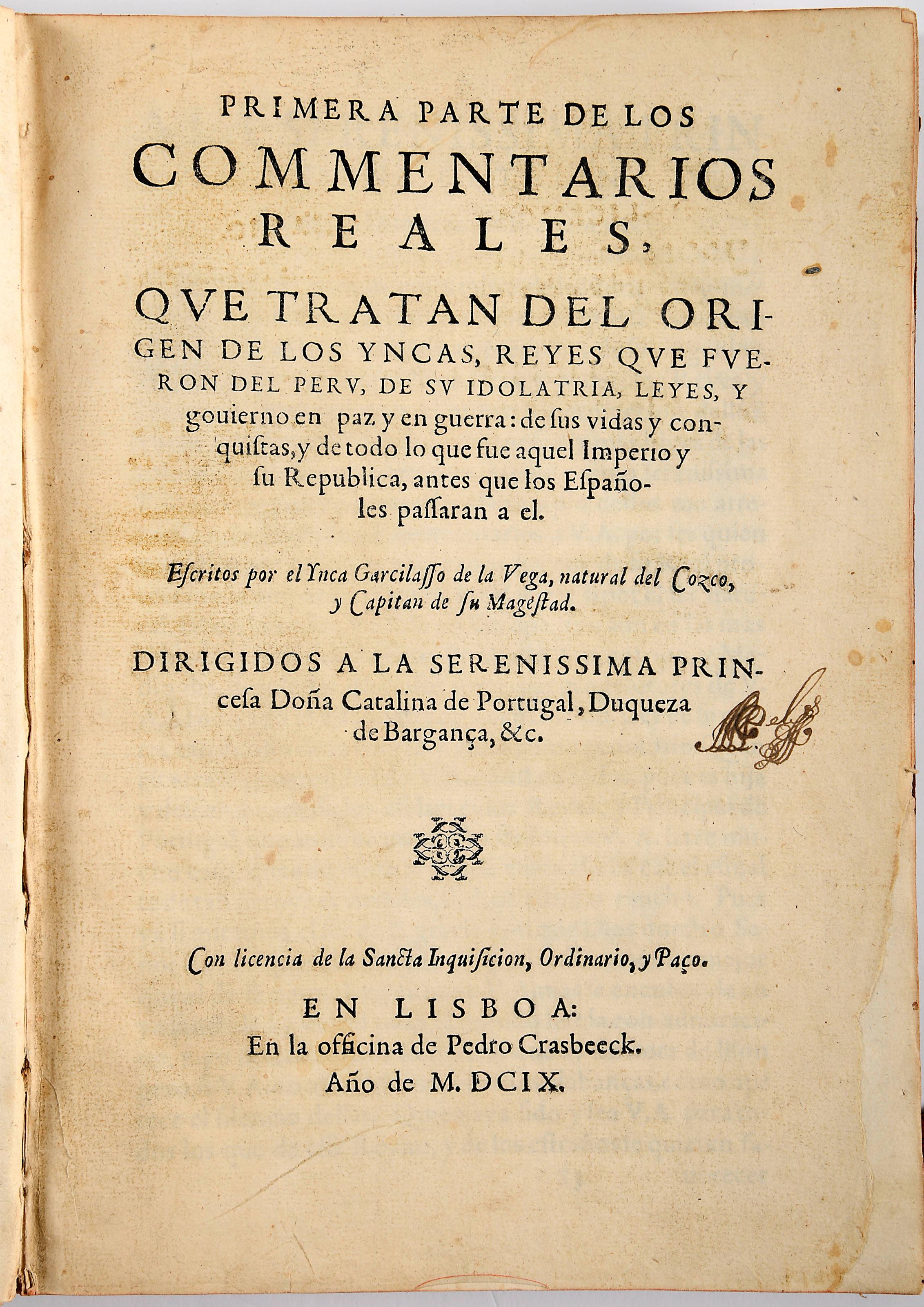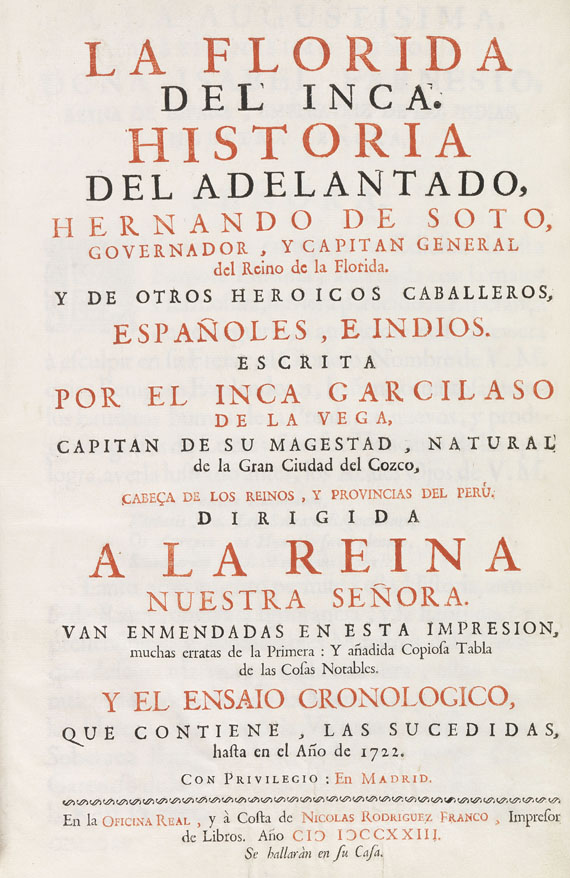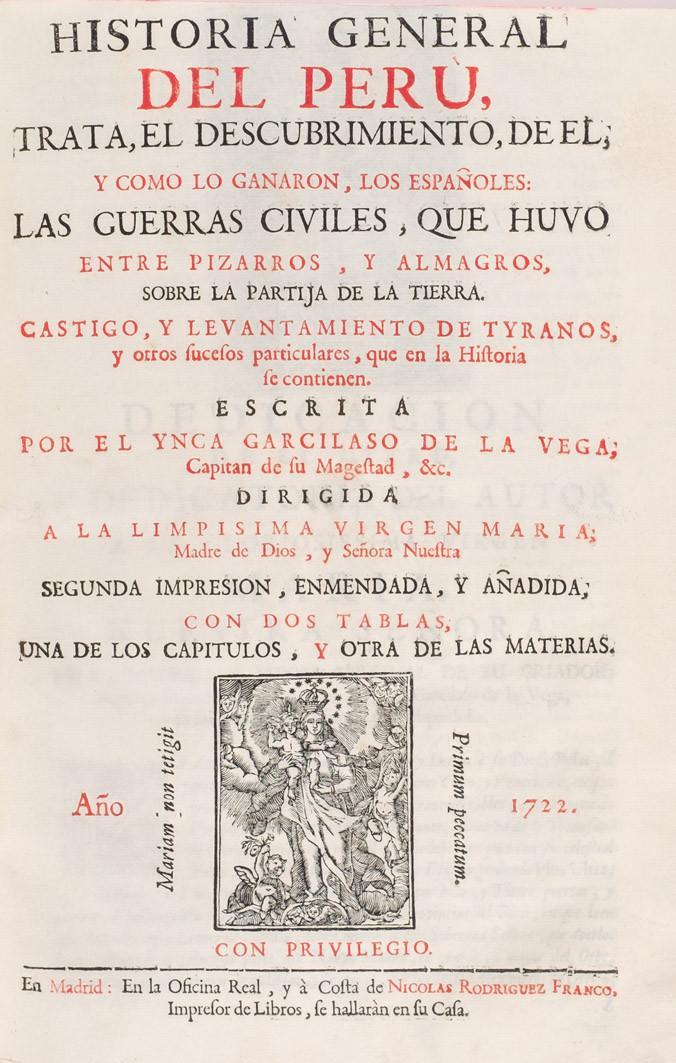Vega, Garcilaso, de la ("El Inca")Historia general del Perv trata el descvbrimiento del; y como lo ganaron los Españoles... [Cordova: Por la viuda de Andres Barrera, y à su costa, 1617]
Folio (267 x 191 mm). Large woodcut vignette on title; title shaved with loss of imprint, a few other leaves shaved with loss of catchwords, some minor worming with occasional loss. Contemporary limp vellum. A an unsophisticated copy of El Inca's history of Peru: a fundamental history of early America, here in its second issue differing from the first only in its variant title-page. The second issue of the second part of Garcailaso de la Vega's famous Historia General or "Royal Commentaries," which had been published first a few months earlier in Cordova in 1616. This issue includes the same text block as the first, with only a variant title-page with a different and larger vignette of the Virgin, and the words "y à su costa" added to the imprint. The first issue is virtually unobtainable and is known in only two copies: the Bibliotheque Nationale, and the John Carter Brown Library. The text and title for the first issue were probably printed in late 1616, indeed the errata leaf includes the date "12. de Novembre de 1616" and the JCB copy contains both the 1616 and 1617 title-pages. For the present second issue, the 1616 title was cancelled and a new re-set title page dated 1617 was added to the original printing of the text. The two parts of Vega's history are actually considered to be two separate but complementary works, which were originally published separately. This second "part" is largely concerned with the period between the Spanish conquest and the civil war in the area. The critic, Menendez y Pelayo, called the Historia General, or "Royal Commentaries," "the most genuinely American book that has ever been written, and perhaps the only one in which a reflection of the soul of the conquered races has survived." "Like the first part, the second is a commentary rather than a history, for... "El Inca" quotes largely from other writers ... always carefully indicating the quotations and naming the authors. But his memory was well stored with anecdotes that he had heard when a boy; and with these he enlivens the narrative" (Winsor 569). Garcilaso de la Vega, known as "El Inca," was born in Peru and spent his formative years there, living out his later life in Spain. His father was a Spanish conquistador and a participant in the events that his son chronicles, while his mother was an Inca princess born in Cuzco. "He was a gentleman of refinement and possessed of much learning, speaking Spanish and Quichua from infancy. A descendant of the proud race of the Incas, he was a most industrious and careful historian of the evil fortunes of his race, as well as a chronicler of the victories of the conquerors" (Maggs). Vega's contemporary record of the early Spanish period in Peru is most valuable, as it is based on eyewitness testimony and personal observation. REFERENCE:European Americana 617/55; Field 590 (note); Le Clerc 614; Maggs, Bibliotheca Americana VI: 413; OCLC 11494608; Medina (BHA) 658; Palau 354789; Sabin 98755; cf. Winsor, Narrative and Critical History of America II: 575
Vega, Garcilaso, de la ("El Inca")Historia general del Perv trata el descvbrimiento del; y como lo ganaron los Españoles... [Cordova: Por la viuda de Andres Barrera, y à su costa, 1617]
Folio (267 x 191 mm). Large woodcut vignette on title; title shaved with loss of imprint, a few other leaves shaved with loss of catchwords, some minor worming with occasional loss. Contemporary limp vellum. A an unsophisticated copy of El Inca's history of Peru: a fundamental history of early America, here in its second issue differing from the first only in its variant title-page. The second issue of the second part of Garcailaso de la Vega's famous Historia General or "Royal Commentaries," which had been published first a few months earlier in Cordova in 1616. This issue includes the same text block as the first, with only a variant title-page with a different and larger vignette of the Virgin, and the words "y à su costa" added to the imprint. The first issue is virtually unobtainable and is known in only two copies: the Bibliotheque Nationale, and the John Carter Brown Library. The text and title for the first issue were probably printed in late 1616, indeed the errata leaf includes the date "12. de Novembre de 1616" and the JCB copy contains both the 1616 and 1617 title-pages. For the present second issue, the 1616 title was cancelled and a new re-set title page dated 1617 was added to the original printing of the text. The two parts of Vega's history are actually considered to be two separate but complementary works, which were originally published separately. This second "part" is largely concerned with the period between the Spanish conquest and the civil war in the area. The critic, Menendez y Pelayo, called the Historia General, or "Royal Commentaries," "the most genuinely American book that has ever been written, and perhaps the only one in which a reflection of the soul of the conquered races has survived." "Like the first part, the second is a commentary rather than a history, for... "El Inca" quotes largely from other writers ... always carefully indicating the quotations and naming the authors. But his memory was well stored with anecdotes that he had heard when a boy; and with these he enlivens the narrative" (Winsor 569). Garcilaso de la Vega, known as "El Inca," was born in Peru and spent his formative years there, living out his later life in Spain. His father was a Spanish conquistador and a participant in the events that his son chronicles, while his mother was an Inca princess born in Cuzco. "He was a gentleman of refinement and possessed of much learning, speaking Spanish and Quichua from infancy. A descendant of the proud race of the Incas, he was a most industrious and careful historian of the evil fortunes of his race, as well as a chronicler of the victories of the conquerors" (Maggs). Vega's contemporary record of the early Spanish period in Peru is most valuable, as it is based on eyewitness testimony and personal observation. REFERENCE:European Americana 617/55; Field 590 (note); Le Clerc 614; Maggs, Bibliotheca Americana VI: 413; OCLC 11494608; Medina (BHA) 658; Palau 354789; Sabin 98755; cf. Winsor, Narrative and Critical History of America II: 575














Testen Sie LotSearch und seine Premium-Features 7 Tage - ohne Kosten!
Lassen Sie sich automatisch über neue Objekte in kommenden Auktionen benachrichtigen.
Suchauftrag anlegen